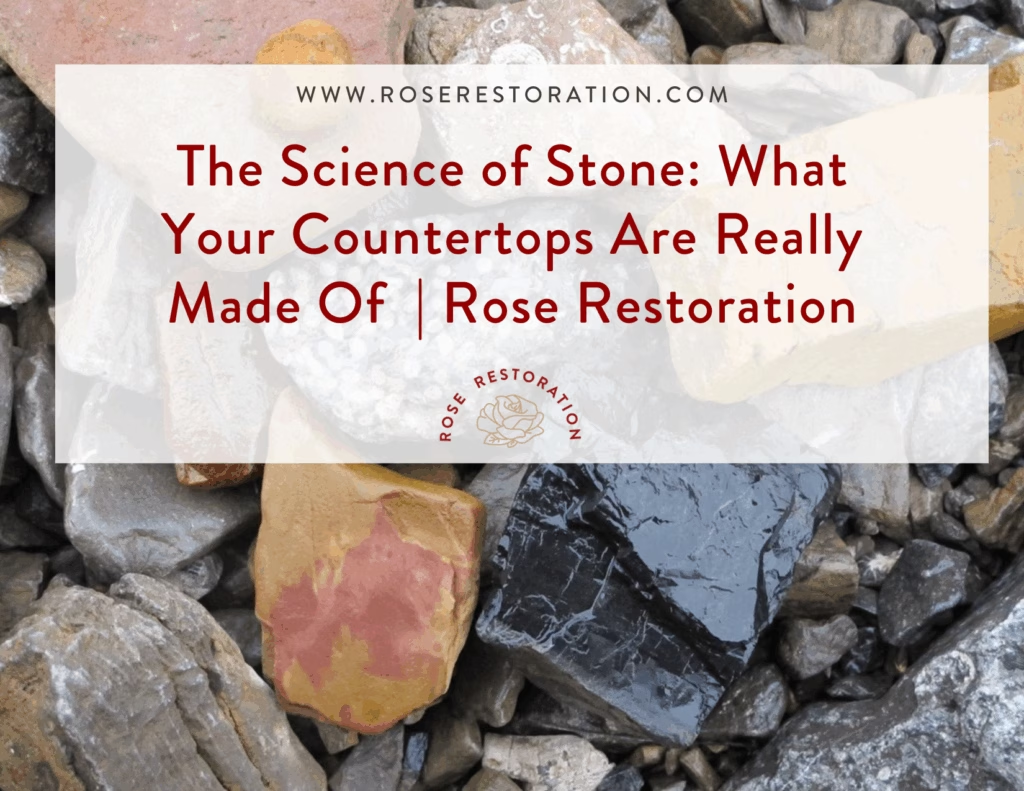Natural stone surfaces aren’t just elegant additions to kitchens, bathrooms, and commercial spaces—they are geological masterpieces, formed over millions of years through extraordinary natural processes. When you run your hand across a marble countertop or admire the rich veining of granite, you’re not just looking at a design choice; you’re connecting with a piece of Earth’s history.
At Rose Restoration, we believe that understanding the origins of these stones empowers homeowners, designers, and architects to care for and protect them properly. By exploring the science behind marble, granite, quartzite, and other stones, you’ll gain a whole new appreciation for the surfaces you live and work with every day.
The Geology Behind Your Favorite Stones
Each type of natural stone has a unique origin story. Their differences in formation explain their strength, porosity, and maintenance needs, which is why some are perfect for high-traffic kitchens while others are better suited for decorative use.
Marble: Limestone’s Stunning Transformation
Marble starts as limestone, a sedimentary rock composed primarily of calcium carbonate. Over millions of years, intense heat and pressure within the Earth’s crust transform limestone into marble, creating its distinctive veining patterns.
Porosity Level: High – absorbs liquids easily, making it vulnerable to staining.
Acid Sensitivity: Extremely sensitive to acidic cleaners like vinegar, lemon juice, or wine.
Common Uses: Bathroom vanities, fireplace surrounds, low-traffic kitchen counters.
Fun Fact: Michelangelo carved the famous David statue from the very same type of marble that graces modern-day luxury homes.
Care Tip: Always use pH-neutral cleaners on marble surfaces and reseal annually to protect against staining and etching.
Granite: Earth’s Unbreakable Armor
Granite forms when magma cools slowly beneath the earth’s surface, creating a dense, interlocking crystal structure. This makes granite one of the hardest natural stones, highly resistant to scratches and heat.
Porosity Level: Low – highly resistant to water and staining, especially when sealed.
Durability: Ideal for high-traffic areas like kitchens, hotels, and outdoor bars.
Composition: Quartz, feldspar, and mica, giving it a sparkling, speckled appearance.
Care Tip: While granite is tough, sealing every 12–18 months helps maintain its stain resistance and keeps surfaces looking brand new.
Quartzite: The Best of Both Worlds
Often confused with quartz, quartzite is a natural metamorphic rock that combines the strength of granite with the beauty of marble. It forms when sandstone is subjected to intense heat and pressure, fusing quartz crystals into a strong, glassy surface.
Durability: Nearly as hard as granite but visually similar to marble with dramatic veining.
Best Uses: Luxury kitchens, statement islands, commercial spaces seeking both durability and elegance.
Care Tip: Seal quartzite regularly to prevent staining, especially in commercial kitchens.
Terrazzo: Modern Sustainability Meets Ancient Craft
Unlike naturally occurring stone, terrazzo is a composite material made from chips of marble, glass, quartz, or granite mixed with a binder such as epoxy. It’s been used for centuries, especially in historic buildings and luxury lobbies.
Eco-Friendly Factor: Often made with recycled materials, making it a sustainable flooring option.
Durability: Can last decades with proper care and polishing.
Why Stone Composition Matters for Maintenance
The way your stone formed determines its long-term care strategy. For example:
Marble’s calcium carbonate base reacts poorly to acids, requiring gentle, pH-neutral cleaning.
Granite’s crystalline structure resists scratches but benefits from sealants to prevent deep staining.
Quartzite’s hardness makes it ideal for commercial spaces but still requires periodic sealing.
Pro Tip: Identify your stone before cleaning it. Using the wrong cleaner can cause permanent damage and reduce the stone’s lifespan.
Common Stone Care Mistakes
Even high-end homeowners and professional property managers make these mistakes:
Using Vinegar or Lemon Juice: These etch marble and limestone surfaces.
Skipping Resealing: Unsealed stone absorbs spills and stains like a sponge.
DIY Polishing Kits: Over-the-counter solutions often cause more harm than good.
Generic Cleaners: Many contain acids or abrasives unsuitable for natural stone.
Fun Fact Corner: Stone Trivia You’ll Love
Granite Glow: Some granite contains natural quartz crystals that glow under UV light.
Marble Migration: The marble in your bathroom might have traveled thousands of miles from quarries in Italy, Greece, or Turkey.
Terrazzo Origins: Ancient Venetians invented terrazzo by recycling marble scraps to create beautiful, sustainable flooring centuries before green design was trendy.
Protecting Your Investment
Whether you’re a homeowner with a marble kitchen island or a hotel manager overseeing granite lobby floors, understanding your stone is the first step to preserving it.
At Rose Restoration, we specialize in:
Marble polishing and restoration
Granite sealing and crack repair
Terrazzo floor polishing and repair
Stone identification and custom care plans
Turn your stone surfaces into lasting masterpieces.
Contact Rose Restoration today for a consultation and expert care tailored to your stone’s unique needs.

